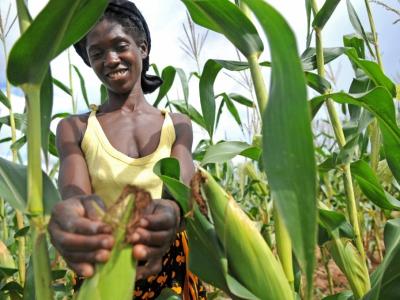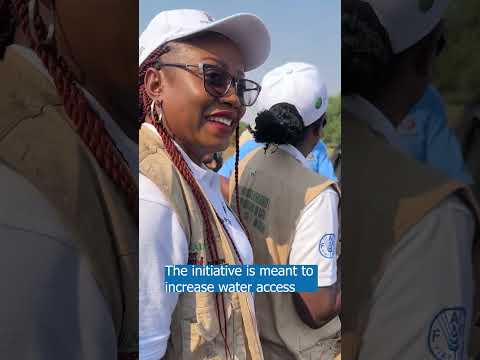
Photo:
The project 'Strengthening climate resilience of agricultural livelihoods in Agro-Ecological Regions I and II in Zambia' supports the Government of Zambia to strengthen the capacity of farmers to plan for climate risks that threaten to derail development gains, promote climate resilient agricultural production and diversification practices to improve food security and income generation, improve access to markets, and foster the commercialization pf climate-resilient agricultural commodities. The project is financed by the Green Climate Fund and implemented by the Zambian Ministry of Agriculture, and will support the Government of Zambia in building climate-resilient food security and poverty reduction measures for approximately 940,000 people.
A coalition mobilized by UNDP, involving the Food and Agriculture Organization of the United Nations (FAO) and World Food Programme (WFP) together with national institutions like the Ministry of Agriculture and Zambia Meteorological Department, will deliver an integrated set of technical services that will help to advance key Sustainable Development Goal targets, especially in SDG#1 for No Poverty and SDG#2 for No Hunger. The coalition will ensure that best practices from pilot climate resilience initiatives nurtured with the support of these organizations will be scaled-up to meet the Government of Zambia’s targets on adapting its economy to climate change impacts.
In all, the Government of Zambia anticipates reaching over 3 million indirect beneficiaries through the project – approximately 18 percent of the total population – which will work in 16 districts within the Agro-Economical Regions: Mambwe, Nyimba, Chongwe, Luangwa, Chirundu, Rufunsa, Chama, Mafinga, Kazungula, Siavonga, Gwembe, Namwala, Shangombo, Senanga, Sesheke and Mulobezi. Farmers living in these districts are especially vulnerable to climate change risks, primarily increasing droughts, variability of rainfall and occasional floods. There is a high rate of poverty, meaning efforts to end hunger and poverty are at risk if we don’t take immediate action to adapt agricultural practices to changing climate conditions.
Hunger and malnutrition are real and present risks in Zambia. Approximately 60 percent of people live below the poverty line, and 42 percent are considered extremely poor. According to WFP, over 350,000 people are considered food insecure, and roughly 40 percent of children experience stunted growth. Given the unique role of women in agriculture and food provisioning, and their unique vulnerabilities to climate change, GCF resources will focus dedicated efforts on building climate resilience for female-headed houses and rural enterprises. The project aligns with Zambia’s key development goals for poverty reduction and food security, as well as its goal to become a prosperous middle-income country by 2030.
This project signals an important step to mobilize these funds in Zambia, scale-up pilot climate resilience projects, and work toward achieving Zambia’s Nationally Determined Contribution to the Paris Agreement. In fulfilling its contribution to the Paris Agreement - and global goals to limit temperature increases to 2 degrees while ensuring no one is left behind in terms of economic and social development - the project will promote the conservation of water, improve the use of irrigation technologies, and strengthen climate information services.
- Community
- National
- National Governments
- United Nations Development Programme (UNDP)
946,153 Direct Beneficiaries, 3 million indirect beneficiaries
- Government of Zambia
- Green Climate Fund
- Food and Agriculture Organization of the United Nations (FAO)
- World Food Programme (WFP)
Expected outcomes
Output 1: Smallholder farmers are able to plan for and manage water resources to support resilient agricultural production
Output 2: Resilient agricultural livelihoods in the face of changing rainfall, increasing drought and occasional floods
Output 3: Increasing farmers' access to markets and commercialization of resilient agricultural products
Adaptation actions will benefit largely the poorest and most vulnerable regions of the country in Agro-Ecological Regions I and II. The grant resources will support innovative investments needed to assist the most vulnerable and poor populations most affected by the impacts of climate change. Through these grants combined with co-financing from the Government of the Republic of Zambia (GRZ), the project will trigger a paradigm shift in the way that small holder farmers undertake climate resilient agriculture - causing a shift from conventional unsustainable agriculture practices to climate resilient practices. The very high co-finance ensures that this project will shift public financing on agriculture towards climate resilient agriculture. In specific, paradigm shift will be achieved by addressing the entire value chain, from planning for climate risk, to ensuring resilience of water and other agricultural inputs, to resilient methods for production, to, ultimately, linking farmers and their climate-smart agriculture products to markets. This innovative approach ensures that climate risks across the value chain are addressed, while also putting in place the necessary technical, financial and institutional foundations to promote and accelerate resilient agricultural value chains that can be viable in the face of climate change.
The GRZ seeks to combine GCF grant resources with co-financing from (i) its budget allocations of MoA, (ii) the Water Resources Management Authority (WARMA), and (iii) UNDP to enhance resilient agro-based value chains for the vulnerable communities in Agro-Ecological Regions I and II. The GRZ has committed large amounts of co-finance, three times the grant request, as strong display of their pledge of their interest in this project. GCF financing will only cover the activities that have a clear climate change additionality like climate information and early warning systems, access to water for smallholder farmers and linkages with rural agricultural markets.
Revenue generated as a result of project interventions will also be used to contribute to farmer and water user organizations for operations and maintenance (O&M). Therefore, the interventions do not lend themselves to reflows back to the Government or the GCF, requiring support in grant financing. GCF funds will not be used for O&M during or after the project.
Economic situation
Zambia remains a poor country despite recent good economic growth. Poverty rates, particularly in rural areas, are relatively high and the Government has identified poverty reduction as one of the main priorities (7NDP, 2017-2022). In fact, the poverty rate in rural areas is almost triple the level observed in urban areas. In 2010 rural poverty was estimated at 77.9 percent compared to urban poverty levels of 27.5 percent. In the 16 target districts, smallholder farmers live on less than US$2 per day. Though more than 80 percent of the targeted farming households live in their own houses, these are mud-thatched whose average value does not go beyond US$50. Based on the World Bank’s 2015 Mapping Subnational Poverty in Zambia (2015), it is evident that the poverty incidence is highly concentrated in Agro-Ecological Regions I and II where rain-fed agriculture is predominant.
The high incidence of poverty is coupled with high food insecurity throughout the country. In 2013, 48.3 percent of the Zambian population was undernourished or food deprived (United Nations Statistics Division, 2014). Between May 2011 and April 2012, 42 percent of rural households experienced food shortages, with the average time of food access shortage of 3.2 months. Stunting rates in rural areas are frequently 52 percent (GRZ, 2013). Diets are very limited, leading to challenges of nutrition. About 50 percent of calorific intake was derived from maize and 14 percent from cassava (Ministry of Agriculture and Livestock, 2011). This heavy reliance on maize as a staple food causes deficiencies in micronutrients. Zambian calorie consumption of vegetables, nuts and pulses is around 2 percent (GRZ, 2013).
Climate risk in Agro-Ecological Regions I and II
There are three major Agro-Ecological Regions in Zambia. Region I, in the southern portion of the Southern and Western provinces, is one of Zambia’s hottest, driest and poorest regions. It is categorized as a low rainfall area, where soils are sandy, characterized by poor fertility. Maize, sorghum, groundnuts, sunflower and cowpeas are cultivated, and some fishing activities are undertaken. This region is particularly vulnerable to climate change, and is categorized as a drought-prone area.
Region II has three subregions (IIa1 and IIa2, and IIb) and is a medium-rainfall belt running East-West through the centre of the country. It is an area with relatively good soils and receives more rainfall than Region I. It has the most favourable agro-ecological conditions in terms of rainfall, soil quality and absence of the tsetse fly. There is also ample irrigation potential. This allows for a diverse mix of crop and livestock enterprises. Region IIb, while often considered a part of Region II, is differentiated from the other parts of the region. It can be characterized as a low-rainfall area in the western part of the country that corresponds mostly to Central/Northern parts of the Western province. This area has lower rainfall and sandier soils, poorer road and market infrastructure, and high risk of droughts. Sorghum and millet are mainly grown as staple crops along with cassava, with some maize also being grown. This drought-prone area is also suited to extensive livestock production, cashew nuts and timber.
It is evident that severe weather/climate events have led to significant drops in GDP growth, especially in the relatively dry Regions I, IIa1 and IIb. The strength of the 2015-16 El Niño and severe drought, comparable in strength to the 1982-83 and 1997-98 El Niño events, led to a significant reduction in GDP growth, especially in the economically important agricultural sector, and it reduced its contribution to GDP. As a consequence, a surge in poverty rates, particularly among smallholder farmers who depend almost exclusively on rain-fed agriculture and have little or no coping mechanism in Regions I, IIa1 and IIb was expected (World Meteorological Organization, El Niño/La Niña Update, 12 May 2016).
Context of agriculture sector
Zambia is a landlocked country with a tropical climate favourable for agriculture and produces a variety of crops including fruits and vegetables. As a result, agriculture is the backbone of Zambia’s economy, with approximately 70 percent of the population engaged in agricultural livelihoods (Sitko & Tembo, 2013; World Bank, 2013). Overall, the agriculture sector accounts for approximately 9.6 percent of national GDP as of 2013 (World Bank). Increasing risks of climate change, particularly related to droughts, highly variable rainfall and occasional floods make these livelihoods extremely vulnerable to climate change. Over the course of the last 30 years, the impacts of floods and droughts have been estimated to cost the country USD 13.8 billion. If no measures were to be taken, climate change is expected to reduce GDP growth by USD 4.3-5.4 billion in the next decade, equivalent to a loss of 0.9 percent to 1.5 percent in GDP growth.
Smallholder subsistence farmers, defined as farmers with farms of less than five hectares in size represent 96 percent of the country’s 1.1 million farmers and cultivate 76 percent of the total cropped area. Most female farmers come under this category. Currently, approximately 48 million hectares of land in Zambia is suitable for agricultural use. This area is suitable particularly for growing staple crops under rain-fed conditions, but is likely to decline by 80 percent by 2100. This would directly affect small-scale farmers in Zambia, most of whom rely on rain-fed systems.
Climate impacts on the agriculture sector
Both Regions I and II are highly exposed to climatic hazards due to more frequent drought and flood events and to lack of adaptive capacities (NAPA, 2007). Projections show that rainfall is expected to be more erratic, less frequent but more intense, with more precipitation coming from extreme events, and that this would be concurrent with a general drying trend overall. The decline in precipitation and shortening of growing seasons would reduce agricultural productivity, while extreme precipitation events could, through flooding and run-off, destroy crops.
In particular, climate variability is forecast to reduce yields of major crops (including maize, sorghum and soybean) (Adhikari et al., 2015) and to reduce total GDP for the agricultural sector by USD 2.2-3.1 billion in midterm projections (10–20 years), representing more than 50 percent of the expected GDP losses from climate change (Zambia INDC, 2015). Rain-fed agriculture, on which small-scale farmers depend, has in the past shown high sensitivity to climate variability in terms of both droughts and floods (Climate Investment Funds, 2011).
Given the diversity of crops grown in the country as well as the climate in the agro-ecological regions, it is also important to understand potential impacts of climate change at a regional level. For example, Agro-Ecological Region I in the south of Zambia has the least rainfall in the country and is considered to be the most vulnerable to climate change (Climate Investment Funds, 2011). Certain crops are likely to do better under climate change scenarios: for example, cassava is considered to be drought tolerant and resistant to high temperatures (Jarvis et al., 2012). Currently, it is grown predominantly in Agro-Ecological Region III as well as parts of Region II.
On the other hand, maize, grown by nearly 83 percent of Zambian households (World Bank, 2013), is considered to be vulnerable to climate change impacts. Maize in particular dominates in Agro-Ecological Regions I and IIa (Hagglade and Nyembe, 2008). Yet as Adhikari et al. (2015) notes, “Despite large variations in projected impact on maize yield, there is a general consensus that climate change will adversely affect maize yield in East Africa [includes Zambia in this study]. Multiple studies indicated that East Africa could lose as much as 40% of its maize production by the end of the 21st century” (pp.116-17).
Output 1: Smallholder farmers are able to plan for and manage water resources to support resilient agricultural production
1.1 Strengthen generation and interpretation of climate information and data collection to ensure timely and detailed weather, climate, crop and hydrological forecasts are available to support smallholder farmers in planning and management of water resources used in resilient agricultural practices
1.2 Strengthen dissemination and use of tailored weather/climate-based agricultural advisories to ensure smallholder farmers receive the information they need for planning and decision-making
Output 2: Resilient agricultural livelihoods in the face of changing rainfall, increasing drought and occasional floods
2.1 Promote irrigation schemes, water storage and capture as well as other resilient water management strategies to increase access to water for agricultural production in the target districts within Agro-Ecological Regions I and II
2.2 Increased access to agricultural inputs (e.g. seeds, soil kits, tools) for resilient crops
2.3 Introduction of new resilient agricultural production practices to strengthen production and diversify crops amidst climate variability and change
2.4 Introduce alternative livelihoods to strengthen resilience in target communities
2.5 Establish farmer field schools and learning centres of excellence to further document and scale up successful practices
Output 3: Increasing farmers' access to markets and commercialization of resilient agricultural products
3.1 Strengthen processing of resilient products
3.2 Strengthen storage, aggregation and transportation of resilient products to enhance commercialization and linkages to market and SMEs
3.3 Increase access to finance and insurance products for smallholder farmers by engaging with potential financing sources including public, private, bilateral and multilateral sources
3.4 Identify available markets and promote climate-resilient products
- UNDPBenjamin LarroquetteRegional Technical Advisor, Climate Change Adaptation





















